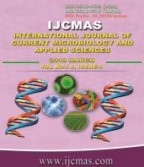


 National Academy of Agricultural Sciences (NAAS)
National Academy of Agricultural Sciences (NAAS)

|
PRINT ISSN : 2319-7692
Online ISSN : 2319-7706 Issues : 12 per year Publisher : Excellent Publishers Email : editorijcmas@gmail.com / submit@ijcmas.com Editor-in-chief: Dr.M.Prakash Index Copernicus ICV 2018: 95.39 NAAS RATING 2020: 5.38 |
Burn wound infections are most serious and often lead to life- threatening complications which are the major cause of morbidity and mortality in burns patients. Generally burn wound has high susceptibility rate of bacterial colonization and infection, this is because of destroyed skin barrier due to burns and which leads to direct bacterimic spread. To detect the prevalence of MRSA producers among Gram positive cocci and ESBL producers among Gram negative bacilli from the burn wound isolates. This Prospective study was conducted for 3 months (May, June July 2017) at Govt. Mohan Kumaramangalam Medical College Hospital, Salem. Under standard protocol 2 Pus samples were collected from each burns patient after 4-5 days of admission irrespective of their age and gender. The isolates were screened for MRSA & ESBL. A total of 76 samples were collected from patients with burns wound infection. Out of that 40 (52.6%) were females and 36 (47.3%) were male patients. Among the total patients, 42% were 20-30yrs, 35.5% were 30-40yrs, 7.8% were 40-50% yrs and 14.4% more than 50 yrs. Out of total samples, 74 (97.3%) were culture positive. 13 (17.1%) were showed poly microbial growth. Among total GPC, 9(40.9%) were MRSA isolates (confirmed by Cefoxitin sensitivity), of which 6(27.2%) were Staphylococcus aureus and 3 (13.6%) were CONS. Among total GNB, 32 (49.2%) were screened as ESBL producers by Ceftazidime sensitivity. The number of isolates confirmed as ESBL producers were 28 (43%) by Combined disc test. So screening of all the isolates in burn wound infection is very much essential. Regular monitoring of burn wound infection is an important tool for infection control practice. Even though the mortality is in-evitable in >75% burns patients, by doing proper surveillance activity in all aspects, treatment failure and morbidity can be prevented.
 |
 |
 |
 |
 |